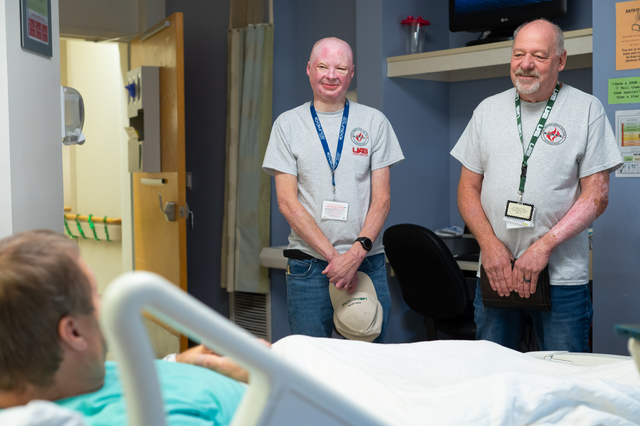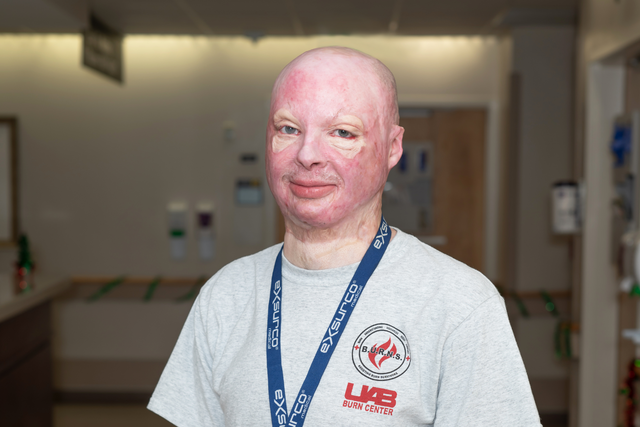Media contact: Anna Jones
 Williams is using his experience to help others. He has now mentored more than 30 burn patients as they continue in their recovery.Running through fire. Third-degree burns. Multiple surgeries. Years of recovery.
Williams is using his experience to help others. He has now mentored more than 30 burn patients as they continue in their recovery.Running through fire. Third-degree burns. Multiple surgeries. Years of recovery.
Not only has Chris Williams, 33, survived all of this, but he is now using his story to serve as an inspiration to other burn survivors at the University of Alabama at Birmingham Hospital.
A tragic house fire and a “grim” outlook
His journey with the UAB Burn Unit began in September 2019.
It was the early morning, still dark outside, and one of his dogs woke him up by licking him and pawing at his chest. He saw the fire outside the window, which began accidentally from a cigarette not quite put out on the front porch. Smoke started pouring into the house. Chris and his girlfriend could not see more than 2 feet in front of them. They fumbled through the dark, making their way to the front door. The only options were to stay in the house and die of smoke inhalation or run through the flames. They ran.
Tragically, Williams’ girlfriend suffered 95 percent burns on her body and did not survive. None of the couple’s five dogs survived. Williams, with 90 percent of his body covered in mostly third-degree burns, was sent to UAB’s Burn Center.
Williams remembers being gurneyed away from the fire and then, two weeks later, waking up in the hospital with his family by his side. He had been placed in a medically induced coma.
James Hwang, M.D., UAB’s burn surgeon, says the injuries Williams sustained are usually not survivable.
The first step to save Williams’ life was to stabilize him, a difficult task with his condition. UAB’s burn and trauma services, along with critical care surgery, nursing, pharmacy, nutrition and therapy, all worked together to get the job done.
“Spray-on skin”
The next step: burn wound resurfacing.
Williams was one of the first patients at UAB to receive an innovative therapeutic procedure that had recently been approved by the United States Food and Drug Administration: “ReCell autologous skin grafting” — also known as “spray-on skin.”
Typically, to heal severe burns, surgeons must do skin-grafting, using a sample of undamaged skin to lay over the burned skin. This process is painful, involves many procedures and can cause more scarring.
The new ReCell treatment involves isolating individual skin cells, immersing them in a liquid suspension with cells that aid in wound healing, then evenly distributing the mixture across the burned skin. ReCell allows for a smaller sample of healthy skin to be used, which is ideal in a case like Williams’, where 90 percent of his body was burned. ReCell was used to heal his arms, chest, back and hands.
“This treatment allowed immediate grafting, and significantly more treatment per surgical procedure,” Hwang said.
 In 2019, Chris Williams survived a house fire with 90 percent burns on his body.The road to recovery
In 2019, Chris Williams survived a house fire with 90 percent burns on his body.The road to recovery
His road to recovery has been difficult, and it is not over yet. But Williams keeps pushing through the physical and emotional pain each day as he continues to recover.
He spent five months in the hospital, and one month at Spain Rehabilitation Center. He has had more than 20 surgeries at UAB — eight surgeries alone on his eyelids. Through it all, Williams says, the care he received at UAB was comforting.
“The burn team was amazing,” Williams said. “They were always nice, they weren’t rough, they took care not to hurt me any more than necessary.”
At Spain, Williams says, the occupational and physical therapists pushed him to his capacity, and he is better for it.
“If they had not pushed and stretched me as much as they did, I wouldn’t have the mobility I have today,” he said. “They worked me through the pain. I let them do it because I knew it was necessary. They apologized every time because they knew it hurt.”
After discharge, the road to recovery continues. For over a year after the fire, he had to change his burn bandages and work to walk well again. He is still receiving treatment.
Healing through family, pets and art
What helped him through his recovery then and now? Williams says the support of his family kept him going, along with his doing “what he was supposed to” during recovery. And while he is still on the road to recovery, Williams says he is now able to do many things that he was able to do prior to the fire.
“Compared to back then, I was struggling to even hold a fork,” Williams said. “Things turned out better than I thought.”
Williams now has three Chihuahuas: Skittles, Charlotte and Yuna. His sister gave him Skittles the day he came home from the hospital, and the name is inspired by one of Williams’ favorite snacks he enjoyed during his time at UAB.
Despite not having the same flexibility and dexterity with his hands as before, Williams enjoys creating with his hands, using a lathe to carve pens, spoons and more out of wood. He has given some of these items as gifts to his care team.
Williams says that Lirong Sun, his current occupational therapist at Spain, was his first customer and has continued to encourage him to pursue his woodworking craft.
“She was very encouraging of my crafts and offered several ideas and pushed me to try making all these different products,” Williams said. “She works not only to further my range of motion and recovery, but also to get back to being a productive member of society.”
Hwang says Williams defied the odds, overcoming setbacks, pain and challenges.
“His amazing will and attitude bulldozed through each obstacle he has faced,” Hwang said.
James Hwang, M.D., and his Burn Care Team at the University of Alabama at Birmingham Burn Clinic hosted the Southern Region Burn Conference earlier this semester.
Coming full circle: the UAB Burn Support Group
During Williams’ months in the hospital, his mom received emotional support through UAB’s Burn Support Group, which was established more than 30 years ago. Nearly two years after Williams had made it home, his mom convinced him to finally go to one of the group meetings.
Williams did not think he needed support. But after that first visit, he has been going ever since.
Late last year, three years after his injuries, Williams began giving back to the group and joined David Hoefflicker — another burn survivor, who has led the support group for the more than 20 years — as a peer mentor to current UAB burn patients.
Williams has now mentored more than 30 patients. He says the support starts with the family members of the patient — just as it had for his mom in his own burn story. Then, as the weeks go by and the patient progresses, the mentors are able to talk with the patient about what their treatment may look like, encourage them in their physical therapy and nutrition, and show them a real-life example of what recovery looks like.
Hoefflicker encouraged Williams to become a mentor, saying he had a good personality for it. Williams also suffered some of the most intense injuries a person can sustain, and yet survived.
“I thought, if it would help, then I might as well try,” Williams said. “No reason not to.”
So, he did.
“Chris Williams has been a great addition to the support group and is instrumental in being a witness to how life goes on even after a traumatic burn injury,” Hoefflicker said.
As someone who knows firsthand what it is like to walk through the fire, physically and metaphorically, Williams can help burn patients see a future beyond their time in the hospital.
“Some people can’t see past the present state they are in, and I can help to talk to them to show that there is a hope for a future past the burns,” Williams said. “If there’s the slightest possibility that what I do can help somebody later, then I’m going to do it.”
UAB Burn Support Group
The UAB Burn Support Group was established in the late 1980s. The support group is to provide assistance and support to families of burn trauma. If you or a loved one is a survivor of a burn injury, contact
To support the UAB Burn Center in its commitment to providing the highest-quality patient care, educating the next generation of surgeons and advancing burn care research, you can make a donation to the Alan R. Dimick Burn Care Education Fund.